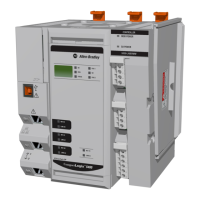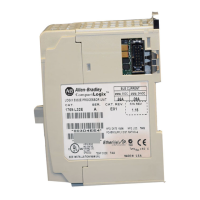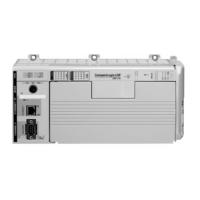32 Rockwell Automation Publication 5069-UM002A-EN-P - January 2019
Chapter 1 CompactLogix 5480 System
Uninterruptible Power Supply
Other Logix 5000 controllers have an internal energy storage module that lets
them save the current state of the project to internal memory when they lose
power. As a result, when power is restored, the controllers resume operation
from the state that was saved.
The CompactLogix 5480 controller does not have an internal energy storage
module. You must connect an external uninterruptible power supply (UPS) to
the UPS control RTB, as shown in
Figure 8 on page 33, to save the state of the
project if the source of MOD power is lost.
Additionally, the COS functions differently based on whether a UPS is
connected to the controller or not. You must connect a UPS to the controller
for the COS to perform an orderly shutdown when MOD power is lost.
When a UPS signals that external power has been lost (UPS buffering), the
controller waits 1 minute for power to be restored. If power is not restored
within 1 minute, the controller saves the project and performs an orderly
shutdown.
We recommend that you use 1606 power supplies from Rockwell Automation
with the UPS control RTB, for example, the 1606-XLS240-UPS power supply.
Table 4 - UPS Control Signals
Signal Description
UPS Ready (R) An input signal from the UPS to the controller that indicates the UPS is working and can
buffer during a power failure.
The charge level for a UPS to be ready to buffer during a power failure varies. For example,
the 1606-XLS240-UPS power supply must be greater than 85% charged to be ready.
The letter R indicates the RTB terminal for this signal.
Buffering (B) An input signal from the UPS to the controller that indicates the UPS battery is providing
power because the external power has failed.
If the buffering signal is present for a minute, the controller performs an orderly
shutdown by stopping execution and saving the state of the controller.
The letter B indicates the RTB terminal for this signal.
Battery Fail (F) An input from the UPS to the controller that indicates the UPS battery has failed, and the
controller cannot operate from stored energy.
In this case, the controller does not attempt to save the state of the program when the
external power fails. The controller issues an alarm if a UPS was previously attached and
ready to buffer.
The letter F indicates the RTB terminal for this signal.
Inhibit (I) This signal commands the UPS to remove power from the system.
The INHIBIT signal is triggered after data is backed up and the system is ready to shut
down.
The letter I indicates the RTB terminal for this signal.

